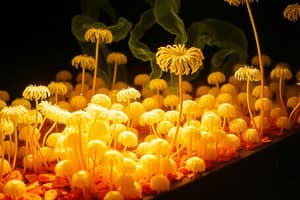Podcast
Questions and Answers
Which type of culture method allows for the proliferation of a single species of microorganism?
Which type of culture method allows for the proliferation of a single species of microorganism?
- Differential culture
- Complex culture
- Selective culture
- Pure culture (correct)
What type of culture medium is specifically designed to distinguish between different types of bacteria?
What type of culture medium is specifically designed to distinguish between different types of bacteria?
- Differential Agar (correct)
- Enrichment Agar
- Nutrient Agar
- Selective Agar
Which of the following is an example of a selective medium used for isolating specific microorganisms?
Which of the following is an example of a selective medium used for isolating specific microorganisms?
- Bacillus Cereus Agar (correct)
- Potato Dextrose Agar
- Blood Agar
- Eosin Methylene Blue Agar
What is the primary function of a general-purpose culture medium?
What is the primary function of a general-purpose culture medium?
Which component is commonly found in complex culture media?
Which component is commonly found in complex culture media?
What is indicated by the changing color from yellow to red in the methyl red test?
What is indicated by the changing color from yellow to red in the methyl red test?
Which hemolytic property corresponds to a complete lysis of red blood cell hemoglobin resulting in a clear zone around the bacterial colony?
Which hemolytic property corresponds to a complete lysis of red blood cell hemoglobin resulting in a clear zone around the bacterial colony?
Which of the following assays utilizes a combination of glucose, sucrose, and lactose to evaluate an organism's fermentation and hydrogen sulfide production capabilities?
Which of the following assays utilizes a combination of glucose, sucrose, and lactose to evaluate an organism's fermentation and hydrogen sulfide production capabilities?
In which plating method are colonies distributed across the surface of the agar during the isolation of microorganisms?
In which plating method are colonies distributed across the surface of the agar during the isolation of microorganisms?
What is the primary purpose of the Disk Diffusion Assay in microbiological testing?
What is the primary purpose of the Disk Diffusion Assay in microbiological testing?
Study Notes
Pure Culture and Cultivation
- Pure culture, also known as axenic culture, contains only one species of microorganism derived from a single cell.
- Cultivation refers to increasing microorganism populations by meeting their nutritional and physical needs.
- Nutrients are extracellular substances essential for protoplasm construction and energy production.
Culture Medium
- Culture medium is nutrient material used for microorganisms' growth and maintenance.
- Functions of culture medium include:
- Supporting microbial growth.
- Facilitating the production of specific compounds.
- Analyzing microbial interactions with medium constituents.
- Types of culture media based on physical state:
- Liquid (broth) contains no solidifying agents.
- Semi-solid contains 0.1-0.5% solidifying agents (e.g., motility tests).
- Solid contains 1.5-2.0% solidifying agents (e.g., agar or gelatin).
Chemical Composition of Culture Medium
- Synthetic media have all components chemically defined.
- Complex media have undefined components (e.g., potato infusion, beef extract, yeast extract).
General Purpose Media
- General purpose media support diverse microorganisms.
- Examples of general purpose media:
- Nutrient Agar supports various bacteria and fungi.
- Potato Dextrose Agar is effective for enumerating molds and yeast.
Differential Media
- Differential media distinguish between different bacteria types using specific reagents, often affecting pH.
- Examples include:
- Eosin Methylene Blue Agar (EMBA) for gram-negative bacteria like E. coli.
- Thiosulphate–citrate–bile salts–sucrose (TCBS) agar for isolating V. cholerae.
Selective Media
- Selective media promote the growth of specific microorganisms using selective agents (salts, dyes, antibiotics).
- Bacillus Cereus Agar (BCA) is designed for detecting Bacillus cereus in food.
Enrichment Media
- Enrichment media increase microorganisms with unique physiological traits by using specific nutrients like blood.
- Blood Agar distinguishes bacteria based on hemolytic properties:
- Beta-hemolysis: complete lysis of red blood cell hemoglobin.
- Alpha-hemolysis: reduction to methemoglobin causing green/brown discoloration.
- Gamma hemolysis: indicates no hemolysis around the colony.
Assay Media
- Assay media have a prescribed composition for measuring vitamins, amino acids, and antibiotics.
- Fermentation Media tests if bacteria can ferment specific carbohydrates.
- Methyl Red Test assesses stable acid production using a color change from yellow to red upon glucose utilization.
- Disk Diffusion Assay measures antimicrobial efficacy by observing inhibition zones' diameters.
- Triple Sugar Iron Medium differentiates enteric bacteria through sugar fermentation and hydrogen sulfide production.
Isolation Techniques
- Plating techniques provide macroscopically visible colonies on solid media.
- Types of plating techniques include:
- Streak Plating isolates pure cultures from mixed populations.
- Spread-Plate Method distributes colonies evenly across the agar surface.
- Pour-Plate Method embeds colonies within the agar and on the surface.
Studying That Suits You
Use AI to generate personalized quizzes and flashcards to suit your learning preferences.
Description
Explore the concepts of pure culture and cultivation in microbiology, focusing on the methods and materials used for microorganism growth. Understand the differences between various types of culture media and their chemical compositions. This quiz will enhance your knowledge of microbial growth techniques and nutrient requirements.




